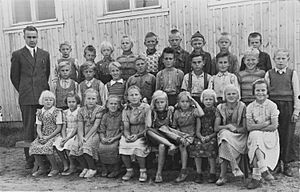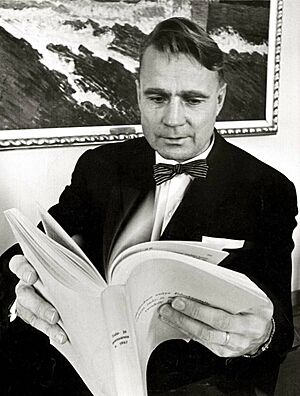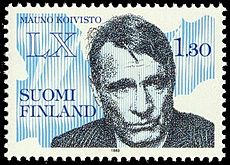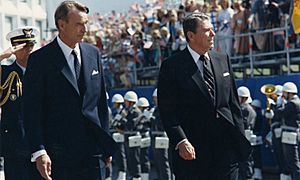Mauno Koivisto facts for kids
Quick facts for kids
Mauno Koivisto
|
|
|---|---|

Koivisto in 1967
|
|
| 9th President of Finland | |
| In office 27 January 1982 – 1 March 1994 |
|
| Prime Minister | Kalevi Sorsa Harri Holkeri Esko Aho |
| Preceded by | Urho Kekkonen |
| Succeeded by | Martti Ahtisaari |
| Prime Minister of Finland | |
| In office 26 May 1979 – 26 January 1982 |
|
| President | Urho Kekkonen |
| Deputy | Eino Uusitalo |
| Preceded by | Kalevi Sorsa |
| Succeeded by | Kalevi Sorsa |
| In office 22 March 1968 – 14 May 1970 |
|
| President | Urho Kekkonen |
| Deputy | Johannes Virolainen |
| Preceded by | Rafael Paasio |
| Succeeded by | Teuvo Aura |
| Deputy Prime Minister of Finland | |
| In office 23 February 1972 – 4 September 1972 |
|
| Prime Minister | Rafael Paasio |
| Preceded by | Päiviö Hetemäki |
| Succeeded by | Ahti Karjalainen |
| Minister of Finance | |
| In office 23 February 1972 – 4 September 1972 |
|
| Prime Minister | Rafael Paasio |
| Preceded by | Päiviö Hetemäki |
| Succeeded by | Johannes Virolainen |
| In office 27 May 1966 – 31 December 1967 |
|
| Prime Minister | Rafael Paasio |
| Preceded by | Esa Kaitila |
| Succeeded by | Eino Raunio |
| Personal details | |
| Born |
Mauno Henrik Koivisto
25 November 1923 Turku, Finland |
| Died | 12 May 2017 (aged 93) Helsinki, Finland |
| Resting place | Hietaniemi Cemetery |
| Political party | Social Democratic |
| Spouse | |
| Children | 1 |
| Signature |  |
| Military service | |
| Branch/service | |
| Years of service | 1939–1944 |
| Rank | |
| Battles/wars | Winter War, Continuation War |
Mauno Henrik Koivisto (born November 25, 1923 – died May 12, 2017) was an important Finnish politician. He served as the ninth President of Finland from 1982 to 1994. Before becoming president, he was the country's prime minister two times. His first term was from 1968 to 1970, and his second was from 1979 to 1982. He was also the first person from the Social Democratic Party to be elected as President of Finland.
| Top - 0-9 A B C D E F G H I J K L M N O P Q R S T U V W X Y Z |
Mauno Koivisto's Early Life & War Service
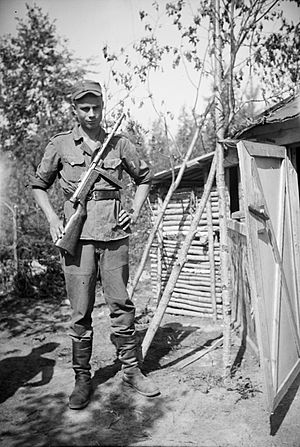
Mauno Koivisto was born in Turku, Finland. He was the second son in his family. His father, Juho Koivisto, worked as a carpenter at a shipyard. Mauno's mother, Hymni Sofia Eskola, passed away when he was only 10 years old.
After finishing primary school, Mauno took on various jobs. When the Winter War began in 1939, he was just 16. He joined a special firefighting unit to help his country.
During the Continuation War, Koivisto served in a special group called Infantry Detachment Törni. This group was led by Lauri Törni and worked behind enemy lines. Only chosen volunteers could join this dangerous unit. For his bravery during the war, he received the Order of the Cross of Liberty. He was also promoted to the rank of corporal.
Later in life, he thought about his time in the war. He said that once you've been in a situation where your life is at risk, everything else seems small.
After the War: Work and Education
After the war, Koivisto worked as a carpenter. He also became very active in politics and joined the Social Democratic Party. In his younger years, he was interested in different political ideas.
In 1948, he found work at the port of Turku. By December 1948, he became the manager of the Harbour Labour Office in Turku. He held this job until 1951.
In 1949, some trade unions tried to cause problems for the government. Koivisto went to the port of Hanko to help keep things running. He worked to recruit new workers and break the strike. Because of his actions, some newspapers saw him as a major opponent.
Mauno Koivisto's Education and Career
Even with his political work, Koivisto kept studying. He passed his intermediate exam in 1947 and his university entrance exam in 1949. In 1951, he became a primary school teacher.
On June 22, 1952, he married Tellervo Kankaanranta. They had one daughter named Assi Koivisto. Assi later helped her father in his presidential campaign.
Koivisto earned a Master of Arts degree from the University of Turku in 1953. He also planned to become a sociologist. Three years later, he finished his doctoral paper. It looked at social relationships in the Turku dockyards. Koivisto also worked as a career counselor for the City of Turku. He was also a member of the Turku City Council.
In 1957, he started working at the Helsinki Workers' Savings Bank. He became its general manager from 1959 to 1968. In 1968, he was chosen to lead the Bank of Finland. He stayed in this important role until 1982. During the 1960s, he worked to improve his party's relationships with other political groups and with President Urho Kekkonen.
Mauno Koivisto's Political Journey
In 1966, the Social Democratic Party won the parliamentary election. Rafael Paasio became Prime Minister, and Koivisto became the Minister of Finance. By 1968, many in his party wanted a new leader. Koivisto became the main choice to replace Paasio as Prime Minister.
Koivisto became Prime Minister for the first time on March 22, 1968. He led the government for two years. After the 1970 election, other parties in his government lost many votes. This led to Koivisto's resignation.
In the 1970s, President Kekkonen began to see Koivisto as a possible future rival. For most of this time, Koivisto focused on his work at the Bank of Finland. In 1979, he returned as Prime Minister. He formed a government with several other parties.
At this point, many people were becoming unhappy with the aging President Kekkonen. His health was failing, and people wanted change. As Prime Minister and head of the Bank of Finland, Koivisto was very popular. He began to be seen as a strong candidate for president.
In 1981, President Kekkonen tried to remove Koivisto from his position as Prime Minister. Some politicians tried to get Parliament to vote against Koivisto's government. This would have stopped Koivisto from running for president while being Prime Minister.
However, Koivisto managed to get enough support to stay in power. He reminded Kekkonen that the Prime Minister answers to Parliament, not the president. This was a very bold move at the time. By October 1981, it was clear Kekkonen was too ill to continue. He resigned, and Koivisto became acting president. This allowed Koivisto to start his presidential campaign from a strong position.
During his campaign, people asked Koivisto about his political beliefs and his relationship with the Soviet Union. He said that his socialism was about the journey, not just the final goal. When asked about the Soviet Union, he said their relationship was "nothing to boast about." This answer made him even more popular. Koivisto did not want to win the election with the Soviet Union's help.
Almost 90% of voters participated in the 1982 presidential election. Koivisto's wife and daughter were part of the special group that voted for president. Koivisto won with 167 out of 301 votes in the first round. His closest opponent received 58 votes.
Koivisto became Finland's first president from the Social Democratic Party. His victory showed that the Social Democrats were now fully accepted in Finland's political life.
Mauno Koivisto's Presidency (1982–1994)
As president, Koivisto preferred a quieter approach. He used less strict leadership than the previous president. He also chose not to use some of his presidential powers. This started a new time of more parliamentary power in Finland.
He sometimes had a difficult relationship with journalists, whom he famously called "lemmings." Reporters found his statements deep and philosophical, which made them hard to understand. This was different from the clear and sometimes harsh statements of the previous president.
At first, he continued Finland's foreign policies in the same way as Kekkonen. This continued until the Soviet Union collapsed. He also continued the practice of sending Soviet defectors back to the Soviet Union. This is now against the Finnish constitution as a human rights violation.
Koivisto built strong relationships with leaders like Mikhail Gorbachev, George H. W. Bush, and Ronald Reagan. He also had very close and trusting ties with leaders from other Nordic countries. He could speak Russian, Swedish, English, and German very well.
When the Soviet Union was falling apart, and countries like Estonia were declaring independence, Koivisto kept Finland neutral. He avoided publicly supporting the Baltic independence movement. However, members of these movements were allowed to work from Finland. Finland recognized the new Estonian government only after major world powers did. Koivisto did secretly send money to Estonia to help their independence movement.
Koivisto made two important diplomatic decisions that changed Finland's position. In 1990, after Germany became one country again, Koivisto announced that Finland would no longer follow parts of the Paris Peace Treaties. These treaties had limited the size and weapons of the Finnish Defence Forces. He argued that if Germany had its full rights, Finland should not be held back by an old treaty. Neither the Soviet Union nor Great Britain officially protested this.
His other big move was ending the Finno-Soviet Treaty in 1991, as the Soviet Union fell. This treaty had guided Finland's foreign policy for decades. A new treaty without military rules replaced it the next year.
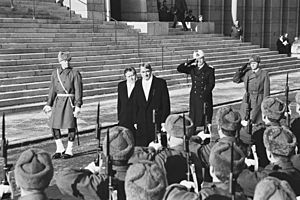
In 1990, Koivisto suggested that any Soviet citizen with Finnish or Ingrian family history could move to Finland. This idea was partly to help Finns living abroad and partly because of worries about a shrinking workforce. This led to changes in immigration laws that year.
After the Soviet Union collapsed, Koivisto was against returning the Karelian old Finnish parts back to Finland.
In the 1988 presidential election, Koivisto was re-elected. He received 189 out of 301 votes in the second round. After the Soviet Union broke up, he supported new ideas like joining the European Union. In 1992, Koivisto started the process for Finland to join the European community. The final details of the membership agreement were completed on the day Koivisto left office. His successor, President Martti Ahtisaari, also supported joining the EU.
Koivisto's popularity dropped sharply during Finland's economic problems in the early 1990s. Many unemployed or struggling citizens felt he could have done more to help the economy. They believed he could have pushed the government to create temporary jobs.
Koivisto's term as president ended in 1994. After that, he wrote his memories in four books. He also continued to share his thoughts on economics and politics.
Mauno Koivisto's Later Years
After his presidency, Koivisto sometimes represented Finland at official events abroad. He attended the funerals of important figures like Queen Ingrid of Denmark in 2000 and Ronald Reagan in 2004.
In 2009, Koivisto chose not to apologize to Estonia. This was regarding his administration's decision not to openly support Estonia's independence movement.
On March 3, 2010, he was hospitalized for a heart problem. However, he was released less than a week later.
Hobby
Volleyball was a favorite hobby of Koivisto for a long time. He started playing in his twenties and continued until he retired.
Death
Koivisto's health got worse in December 2016 due to Alzheimer's disease. His wife, Tellervo, became his main caregiver. In January 2017, Koivisto fell at home and broke his hand. After this, he moved to a nursing home. In May 2017, Koivisto received special care for the end of his life. He passed away on May 12, 2017, at the age of 93.
His state funeral was held on May 25, 2017. Mauno Koivisto is buried in the Hietaniemi Cemetery in Helsinki.
Honours and Awards
| Coat of Arms of Mauno Koivisto | |
|---|---|
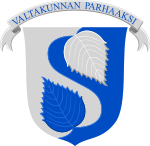 |
|
| Armiger | Mauno Koivisto |
| Adopted | 1983 |
| Motto | "Valtakunnan parhaaksi" ("For the best of the Realm") |
Awards and Decorations
Mauno Koivisto received many awards and decorations from Finland and other countries.
National Orders (Finland)
- Grand Cross of the Order of the White Rose
- Grand Cross of the Order of the Lion of Finland
- Grand Cross of the Order of the Cross of Liberty
- Grand Cross of the Order of the Holy Lamb (from the Orthodox Church of Finland)
Foreign Orders (Other Countries)
 Sweden: Knight of the Order of the Seraphim (1982)
Sweden: Knight of the Order of the Seraphim (1982) Norway: Grand Cross of the Order of St. Olav (1983)
Norway: Grand Cross of the Order of St. Olav (1983) Denmark: Knight of the Order of the Elephant (1983)
Denmark: Knight of the Order of the Elephant (1983) Iceland: Grand Cross with Collar of the Order of the Falcon (1982)
Iceland: Grand Cross with Collar of the Order of the Falcon (1982) Estonia: 1st Class Cross of the Order of the Cross of Terra Mariana (2001)
Estonia: 1st Class Cross of the Order of the Cross of Terra Mariana (2001) Germany: Order of Merit of the Federal Republic of Germany
Germany: Order of Merit of the Federal Republic of Germany Japan: Order of the Chrysanthemum
Japan: Order of the Chrysanthemum Portugal: Collar of the Order of Prince Henry (1992)
Portugal: Collar of the Order of Prince Henry (1992) Italy: Knight Grand Cross with Collar of the Order of Merit of the Italian Republic (1993)
Italy: Knight Grand Cross with Collar of the Order of Merit of the Italian Republic (1993) France: Legion of Honour
France: Legion of Honour France: National Order of Merit
France: National Order of Merit Soviet Union: Order of Lenin
Soviet Union: Order of Lenin Luxembourg: Order of the Gold Lion of the House of Nassau
Luxembourg: Order of the Gold Lion of the House of Nassau Poland: Order of the Merit of the People's Republic of Poland
Poland: Order of the Merit of the People's Republic of Poland Poland: Order of the White Eagle
Poland: Order of the White Eagle Austria: Decoration of Honour for Services to the Republic of Austria
Austria: Decoration of Honour for Services to the Republic of Austria Bulgaria: Order of Stara Planina
Bulgaria: Order of Stara Planina Nepal: Order of Ojaswi Rajanya
Nepal: Order of Ojaswi Rajanya Jordan: Order of al-Hussein bin Ali
Jordan: Order of al-Hussein bin Ali Hungary: Order of Flag of the People's Republic of Hungary
Hungary: Order of Flag of the People's Republic of Hungary Hungary: Order of Merit of Hungary
Hungary: Order of Merit of Hungary Netherlands: Order of the Netherlands Lion
Netherlands: Order of the Netherlands Lion Yugoslavia: Order of the Yugoslav Star
Yugoslavia: Order of the Yugoslav Star Czechoslovakia: Order of the White Lion (1987)
Czechoslovakia: Order of the White Lion (1987) San Marino: Order of San Marino
San Marino: Order of San Marino East Germany: Star of People's Friendship
East Germany: Star of People's Friendship Colombia: Order of San Carlos
Colombia: Order of San Carlos
Honorary Degrees
Koivisto also received honorary degrees from several universities:
- University of Helsinki (Finland) in 1990 and 1988
- Charles University in Prague (Czechoslovakia) in 1987
- University of Tampere (Finland) in 1985
- University of Toulouse (France) in 1983
- Åbo Akademi (Finland) in 1978
- University of Turku (Finland) in 1977
See also
 In Spanish: Mauno Koivisto para niños
In Spanish: Mauno Koivisto para niños


